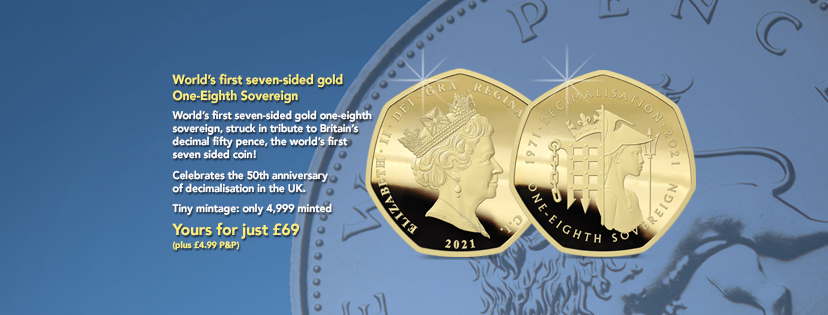
This year marks the 50th anniversary of decimalisation in Britain, heralding in a new era of coins, and saying goodbye to over a thousand years of iconic designs. In our latest sovereign range, the talented artist Matt Dent has captured the old and the new beautifully. In tribute a tribute to Britain’s decimal fifty pence, these are the world’s first seven-sided sovereigns!
Each sovereign is split down the middle with a pre-decimal design on the left, and the design of a decimal coin complementing it on the right. Here, we take a look at the designs for each coin from the new 2021 50th Anniversary of Decimalisation Gold Sovereign Range.
One-Eighth Sovereign
The One-Eighth sovereign shows the designs of the pre-decimal threepence, and the decimal fifty pence.
The formidable Henry Tudor portcullis gate adorns the pre-decimal threepence, and the left-hand side of the one-eighth sovereign. The design was the work of English coin designer, engraver, and calligrapher, William Gardner, and it appeared on the threepence after Queen Elizabeth II came to the throne in 1953.
The right-hand side of the coin shows Britannia, the female warrior holding a trident and shield, which was the image that featured on the decimal fifty pence. This was the work of sculptor and coin designer, Christopher Ironside.
Quarter Sovereign
The design representing the pre-decimal era on the Quarter sovereign is that of the Three Lions, which appeared on the English shilling since the start of Queen Elizabeth II’s reign and again was the work of William Gardner.
For the decimal side of the Quarter sovereign you have the heraldic emblem of the Tudor Rose which appeared on the twenty pence. It was also a William Gardner design, which was first minted in 1982.
Half Sovereign
Sir Francis Drake’s ship, “The Golden Hind” was the design that appeared on the reverse of the pre-decimal half penny. Appearing on the coin from 1937 until decimalisation, it was designed by English coin designer Thomas Humphrey Paget, and it is the design that represents the pre-decimal side of our new half sovereign.
The design representing the decimal era on the half sovereign is inspired by the crowned Scottish thistle with a number 5 below it, which was designed by Christopher Ironside, and was the design on the reverse of the decimal five pence.
Full Sovereign
The final coin is the full sovereign. For the pre-decimal side of the reverse, we again have Britannia which appeared on the pre-decimal penny. Britannia first appeared on the penny in 1806, designed by the engraver Conrad Heinrich Kuchler.
It would go on to have three further redesigns, all featuring Britannia, firstly in in 1825, with a design by the great Victorian designer, William Wyon. Then in 1860, by Wyon’s eldest son Leonard, with a further design, again by Leonard Charles Wyon in 1895.
The decimal side of the full sovereign features the Badge of the Prince of Wales that appeared on the decimal two pence. It shows three ostrich feathers emerging from a gold coronet, above the German motto “Ich Dien” meaning “I Serve”. This was the design of Christopher Ironside.
They are designs that are synonymous with Britain, and for anyone interested in coins, this range will keep them forever in our memory. Matt Dent, the artist behind the concept of these new sovereigns, is the artist behind the reverse of Britain’s currently circulating coinage.
If you would like to purchase from the 50th Anniversary of Decimalisation range, you can do so HERE.
